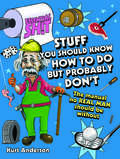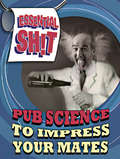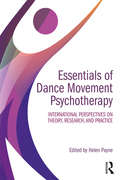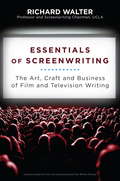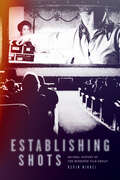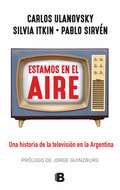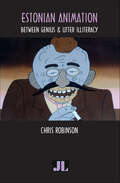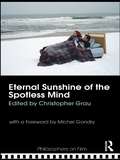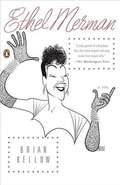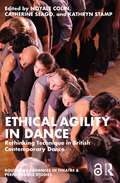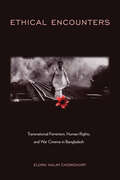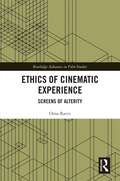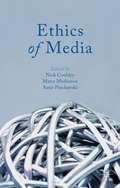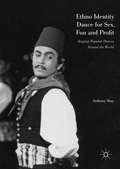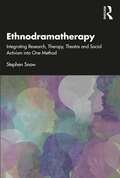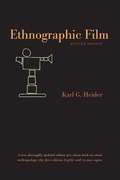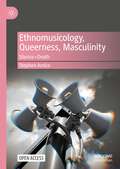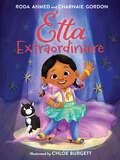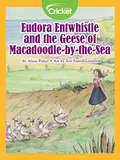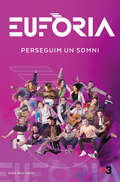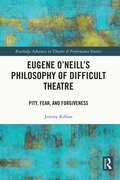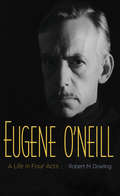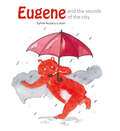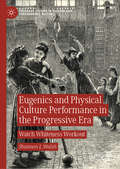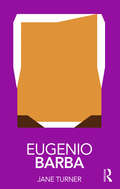- Table View
- List View
Essential Shit - Stuff You Should Know How to Do, but Probably Don't (Essential Shit)
by Kurt AndersonBlokes don't know everything but fortunately this invaluable guide features every manly activity a real guy should be able to do. So sit back, crack open a cold one and let your education commence. From changing a flat tyre to chopping down a tree, operating a drill convincingly and even downing a shot without making a face...this manual has it all! This little gem is packed with hidden secrets and clever solutions. So read, learn and live it. You'll never have to ask for directions again.
Essential Shit: Pub Science to Impress Your Mates (Essential Shit)
by Randall PefferThis is science but not as you know it - here you get all the really cool stuff they didn't teach you in the classroom but you've always wanted to know...For example, ever wondered why hair grows out your nose and ears and if cockroaches really would survive a nuclear blast? Do you wish you could crush a beer can on your forehead or open a door with a credit card? Then look no further, all will be explained here. This is the ultimate science textbook and will answer all your craziest science questions with clarity, practical guidance and, of course, mirth. This is the perfect source of pub ammo.
Essentials of Dance Movement Psychotherapy: International Perspectives on Theory, Research, and Practice
by Helen PayneEssentials of Dance Movement Psychotherapy contributes to the global interest in embodiment approaches to psychotherapy and to the field of dance movement psychotherapy specifically. It includes recent research, innovative theories and case studies of practice providing an inclusive overview of this ever growing field. As well as original UK contributions, offerings from other nations are incorporated, making it more accessible to the dance movement psychotherapy community of practice worldwide. Helen Payne brings together well-known, experienced global experts along with rising stars from the field to offer the reader a valuable insight into the theory, research and practice of dance movement psychotherapy. The contributions reflect the breadth of developing approaches, covering subjects including: • combining dance movement psychotherapy with music therapy; • trauma and dance movement psychotherapy; • the neuroscience of dance movement psychotherapy; • the use of touch in dance movement psychotherapy; • dance movement psychotherapy and autism; • relational dance movement psychotherapy. Essentials of Dance Movement Psychotherapy will be a treasured source for anyone wishing to learn more about the psychotherapeutic use of creative movement and dance. It will be of great value to students and practitioners in the arts therapies, psychotherapy, counselling and other health and social care professions.
Essentials of Screenwriting
by Richard WalterHollywood's premier teacher of screenwriting shares the secrets of writing and selling successful screenplays Anyone fortunate enough to win a seat in Professor Richard Walter's legendary class at UCLA film school can be confident their career has just taken a quantum leap forward. His students have written more than ten projects for Steven Spielberg alone, plus hundreds of other Hollywood blockbusters and prestigious indie productions, including two recent Oscar winners for best original screenplay-Milk (2008) and Sideways (2006). In this updated edition, Walter integrates his highly coveted lessons and principles from Screenwriting with material from his companion text, The Whole Picture, and includes new advice on how to turn a raw idea into a great movie or TV script-and sell it. There is never a shortage of aspiring screenwriters, and this book is their bible.
Establishing Shots: An Oral History of the Winnipeg Film Group
by Kevin NikkelA behind-the-scenes account of a cultural institution that made a distinctive mark on Canadian film Establishing Shots captures a diverse group of filmmakers in an immersive oral history of one of the most important and notorious artist-run centres in Canada: the Winnipeg Film Group. Both a deep dive into the life of an internationally renowned institution and an exploration of the growth of an experimental film movement, this richly illustrated collection of interviews produces a vibrant picture of the Winnipeg Film Group’s origins, successes, failures, and ongoing impact. Formed in 1974 as a membership-based film production, training, and exhibition cooperative, the Winnipeg Film Group was part of a wave of artist-run centres funded by the Canada Council for the Arts. Kevin Nikkel’s candid conversations with twenty-nine administrators and filmmakers— including Guy Maddin, Shawna Dempsey, and Matthew Rankin—reveal the precarious path of independent artists, struggles for equality within the industry, and the importance of place in their work. An engaging resource for scholars and historians of Manitoban and Canadian culture and film, Establishing Shots also shows emerging filmmakers how other artists got their start and learned their craft.
Estamos en el aire: Una historia de la television en la Argentina
by Carlos Ulanovsky Pablo Sirvén Silvia Itkin<P>En 17 de octubre de 1951, tres cámaras apuntaron desde el Banco Nación hacia los balcones de la Casa Rosada para registrar la nada casual coincidencia entre el nacimiento ese día de la televisión argentina y el masivo acto con el que el peronismo celebraba su cumpleaños N° 6 en la Plaza de Mayo. Fue el último al que asistió Evita, ya entonces gravemente enferma, y artífice de la llegada de ese nuevo medio que encargó desarrollar a su antiguo empleador y mentor artístico en Radio Belgrano, don Jaime Yankelevich. Sesenta y cinco años más tarde, y a diecisiete de su primera edición, Estamos en el aire. Una historia de la televisión en la Argentina, sigue siendo el libro que mejor registra el recorrido del más popular de los medios de comunicación a lo largo del febril siglo XX. <P> Enorme tarea de rescate de cientos de personajes, programas, acontecimientos políticos y culturales que quedaron grabados para siempre en el recuerdo de varias generaciones. Los grandes éxitos y los grandes fracasos, las anécdotas más divertidas, los ratings récords, las biografías que no pueden faltar; todo está en Estamos en el aire, la enciclopedia más completa sobre la TV argentina contada por tres expertos/testigos/televidentes de esa epopeya audiovisual. <P>Carlos Ulanovsky narra en la sección “Fundación, estilos y costumbres” el período pionero, entre aquel octubre del 51 y 1966. Silvia Itkin desarrolla dos épocas cruciales: la más dorada, desde el inicio de 1967, hasta la más sombría a fines de 1982, bajo el título “Años de oro. Años de barro”. Pablo Sirvén relata en “Del fin de la inocencia a la globalización” la etapa que va desde el luminoso 1983 hasta el más desencantado 1998, que ya preanunciaba la hecatombe socioeconómica del nuevo siglo/milenio que despuntaba. <P>En esta nueva edición, se agregan tres epílogos de cada autor para revisar qué ha sido de esos años historiados en relación al presente. Textos que iluminan respecto del tipo de televidentes en que nos hemos convertido en la compleja era de las redes sociales y de las variadas y complicadas, pero también estimulantes realidades reales y virtuales que nos atraviesan como sociedad.
Estonian Animation: Between Genius & Utter Illiteracy
by Chris RobinsonEver wonder why Estonian animation features so many carrots or why cows often perform pyramids? Well, neither question is answered in Chris Robinson's new book, Estonian Animation. Robinson's frank, humorous, and thoroughly researched book traces the history of Estonia's acclaimed animation scene from early experiments in the 1930s to the creation of puppet (Nukufilm) and cel (Joonisfilm) animation studios during the Soviet era, as well as Estonia's surprising international success during the post-Soviet era. In addition, Robinson writes about the discovery of films by four 1960s animation pioneers who, until the release of this book, had been unknown to most Estonian and international animation historians.
Eternal Sunshine of the Spotless Mind (Philosophers on Film)
by Christopher GrauEternal Sunshine of the Spotless Mind is one of the most widely discussed and thought-provoking films of recent years. This is the first book to explore and address the philosophical aspects of Eternal Sunshine of the Spotless Mind. Beginning with a helpful introduction that places each essay in context, specially commissioned chapters examine the following topics: philosophical issues surrounding love, friendship, affirmation and repetition the role of memory (and the emotions) in personal identity and decision-making the morality of imagination and ethical importance of memory philosophical questions about self-knowledge and knowing the minds of others the aesthetics of the film considered in relation to Gondry’s other works and issues in the philosophy of perception Including a foreword by Michel Gondry and a list of further reading, this volume is essential reading for students interested in philosophy and film studies.
Ethel Merman
by Brian KellowMore than twenty years after her death, Ethel Merman continues to set the standard for American musical theater. The stories about the supremely talented, famously strong-willed, fearsomely blunt, and terrifyingly exacting woman are stuff of legend. But who was Ethel Agnes Zimmermann, really? Brian Kellow's definitive biography of the great Merman is superb, and the first account to examine both the artist and the woman with as much critical rigor as empathy. Through dozens of interviews with her colleagues, friends, and family members, Kellow traces the arc of her life and her thirty-year singing career to reveal many surprising facts about Broadway's biggest star.
Ethical Agility in Dance: Rethinking Technique in British Contemporary Dance (Routledge Advances in Theatre & Performance Studies)
by Noyale Colin Catherine Seago Kathryn StampThis edited collection examines the potential of dance training for developing socially engaged individuals capable of forging ethical human relations for an ever-changing world and in turn frames dance as a fundamental part of human experience. This volume draws together a range of critical voices to reflect the inclusive potential of dance. The contributions offer perspectives on contemporary dance training in Britain from dance educators, scholars, practitioners and artists. Through examining the politics, values and ethics of learning dance today, this book argues for the need of a re-assessment of the evolving practices in dance training and techniques. Key questions address how the concept of ‘technique’ and associated systems of training in dance could be redefined to enable the collaboration of skills and application of ideas necessary to twenty-first-century dance. The editors present these ideas in different modes of writing. This collection of essays, conversations and manifestos offers a way to explore, debate and grasp the shifting values of contemporary dance. Examining these values in the applied field of dance reveals a complex and contrasting range of ideas, encompassing broad themes including the relationships between individuality and collectivity, rigour and creativity, and virtuosity and inclusivity. This volume points to ethical techniques as providing a way of navigating these contrasting values in dance. It serves as an invaluable resource for academics as well as practitioners and students.
Ethical Encounters: Transnational Feminism, Human Rights, and War Cinema in Bangladesh
by Elora Halim ChowdhuryEthical Encounters is an exploration of the intersection of feminism, human rights, and memory to illuminate how visual practices of recollecting violent legacies in Bangladeshi cinema can conjure a global cinematic imagination for the advancement of humanity. By examining contemporary, women-centered Muktijuddho cinema—features and documentaries that focus on the Bangladesh Liberation War of 1971—Elora Chowdhury shows how these films imagine, disrupt, and reinscribe a gendered nationalist landscape of trauma, freedom, and agency. Chowdhury analyzes Bangladeshi feminist films including Meherjaan, and Itihaash Konna (Daughters of History), as well as socially-engaged films by activist-filmmakers including Jonmo Shathi (Born Together), and Shadhinota (A Certain Liberation), to show how war films of Bangladesh can generate possibilities for gender justice. Chowdhury argues that justice-driven films are critical to understanding and negotiating the layered meanings and consequences of catastrophic human suffering yet at the same time they hint at subjectivities and identities that are not reducible to the politics of suffering. Rather, they are key to creating an alternative and disruptive archive of feminist knowledge—a sensitive witnessing, responsible spectatorship, and just responsibility across time, and space. Drawing on Black and transnational feminist critiques, Chowdhury explores questions around women’s place, social roles, and modes of participation in war as well as the visual language through which they become legible as victims/subjects of violence and agents of the nation. Ethical Encounters illuminates the possibilities of film as a site to articulate an ethics that acknowledges a founding violence of the birth of a nation, recuperates it even if in fragments, and imagines differently the irreconcilable relationship between humanity, liberty, and justice.
Ethics of Cinematic Experience: Screens of Alterity (Routledge Advances in Film Studies)
by Orna RavivEthics of Cinematic Experience: Screens of Alterity deals with the relationship between cinema and ethics from a philosophical perspective, finding an intrinsic connection between film spectatorship and the possibility of being open to different modes of alterity. The book’s main thesis is that openness to otherness is already found in the basic structures of cinematic experience. Through a close examination of the ethical relevance of the philosophy of Maurice Merleau-Ponty, Stanley Cavell, Emmanuel Levinas and Gilles Deleuze to cinema studies, Ethics of Cinematic Experience: Screens of Alterity pursues the question of how film can open the viewer to what is not her, and so bring her to encounter otherness in a way that is unique to cinematic experience. The book sees ethics as not just the subject, content or story of a film but part of its aesthetic structure. Accompanied by readings of films mainly from mainstream cinema, each chapter focuses on a different aspect of the encounter with alterity through cinema. The book gives particular attention to how theoretical discussion of the cinematic close-up can lead to ethical insights into the status of both the human and the non-human in film, and thus lead to an understanding of the relationships the viewer makes with them. The book is a helpful resource for students and scholars interested in the relationship between philosophy, film and ethics, and is appropriate for students of philosophy and media and cultural studies.
Ethics of Media
by Nick Couldry Mirca Madianou Amit PinchevskiEthics of Media reopens the question of media ethics. Taking an exploratory rather than prescriptive approach, an esteemed collection of contributors tackle the diverse areas of moral questioning at work within various broadcasting practices, accommodating the plurality and complexity of present-day ethical challenges posed by the world of media.
Ethno Identity Dance for Sex, Fun and Profit
by Anthony ShayPeople all over the world dance traditional and popular dances that havebeen staged for purposes of representing specific national and ethnic groups. Anthony Shay suggests these staged dance productions be called "ethno identitydances", especially to replace the term "folk dance," which Shay suggestsshould refer to the traditional dances found in village settings as an organicpart of village and tribal life. Shay investigates the many motives that impelpeople to dance in these staged productions: dancing for sex or dancing sexydances, dancing for fun and recreation, dancing for profit - such as dancingfor tourists - dancing for the nation or to demonstrate ethnic pride. In thisstudy Shay also examines belly dance, Zorba Dancing in Greek nightclubs andrestaurants, Tango, Hula, Irish step dancing, and Ukrainian dancing.
Ethnodramatherapy: Integrating Research, Therapy, Theatre and Social Activism into One Method
by Stephen SnowEthnodramatherapy explores the integration of the performance ethnography method, known as ethnodrama, with the principles and practices of drama therapy to establish a sound theoretical formulation for ethnodramatherapy, and considers its use as art, as therapy, as research and as a vehicle for social justice. The book begins by defining ethnodramatherapy – an original synthesis created by the author through deep study and practice of Mienczakowski’s enthnodrama, combined with 35 years of his own practice and research in drama therapy, creative arts therapies and therapeutic theatre. The book describes the origins of ethnodramatherapy, along with its evolution and method. It then delves into applications of the practice highlighted by five case studies with different audiences in different settings. Subjects include adults with developmental disabilities, female adolescents in youth protection, caregivers for loved ones with mental illnesses and Chinese students exploring controversial issues of oppression in China. Complex ethical issues are reviewed and suggestions are made on how to deal with some of the challenging ethical situations that are likely to arise in the ethnodramatherapy process. What emerges is a powerful tool that harnesses theatrical art, ethnographic research and the clinical techniques of drama therapy to create a potential for emancipatory experience for both performers and audiences. This exciting and dynamic synthesis of drama therapy, performance ethnography, theatrical art and social activism will be of interest to the whole community of theatre practitioners and scholars who use theatre to effect individual and social change, including the disciplines of applied theatre, theatre education, experimental theatre, performance studies, and, of course, drama therapy, psychodrama and the other creative arts therapies.
Ethnographic Film
by Karl G. HeiderFrom reviews of the first edition:"Ethnographic Film can rightly be considered a film primer for anthropologists. "-Choice"This is an interesting and useful book about what it means to be ethnographic and how this might affect ethnographic filmmaking for the better. It obviously belongs in all departments of anthropology, and most ethnographic filmmakers will want to read it. "-EthnohistoryEven before Robert Flaherty released Nanook of the North in 1922, anthropologists were producing films about the lifeways of native peoples for a public audience, as well as for research and teaching. Ethnographic Film (1976) was one of the first books to provide a comprehensive introduction to this field of visual anthropology, and it quickly became the standard reference. In this new edition, Karl G. Heider thoroughly updates Ethnographic Film to reflect developments in the field over the three decades since its publication, focusing on the work of four seminal filmmakers-Jean Rouch, John Marshall, Robert Gardner, and Timothy Asch. He begins with an introduction to ethnographic film and a history of the medium. He then considers many attributes of ethnographic film, including the crucial need to present "whole acts," "whole bodies," "whole interactions," and "whole people" to preserve the integrity of the cultural context. Heider also discusses numerous aspects of making ethnographic films, from ethics and finances to technical considerations such as film versus video and preserving the filmed record. He concludes with a look at using ethnographic film in teaching.
Ethnomusicology, Queerness, Masculinity: Silence=Death
by Stephen AmicoThis open access book explores the disciplinary, disciplined, and recent interdisciplinary sites and productions of ethnomusicology and queerness, arguing that both academic realms are founded upon a destructive masculinity—indissolubly linked to coloniality and epistemic hegemony—and marked by a monologic, ethnocentric silencing of embodied, same-sex desire. Ethnomusicology’s fetishization of masculinizing fieldwork; queerness’s functioning as Anglophone master category; and both domains’ devaluation of sensuality and experience, concomitant with an adherence to provincial, Western conceptions of knowledge production, are revealed as precluding the possibilities for equitable, dialogic pluriversality. Enlisting the sonic as theoretical intervention, the disciplined/disciplining ethno and queer are reimagined in relation to negative emotions and intractable affect, ultimately vanquished, and replaced by explorations of sound, sex/uality, and experiential somaticity within a protean, postdisciplinary space of material/epistemic equity. This uncompromising, long-overdue critique will be of interest to researchers and students from numerous theoretical backgrounds, including music, sound, gender, queer, and postcolonial/decolonial studies.
Etta Extraordinaire
by Roda Ahmed Charnaie GordonEtta Extraordinaire has descriptive copy which is not yet available from the Publisher.
Eudora Entwhistle and the Geese of Macadoodle-by-the-Sea
by Alicia PotterEudora loves her musical geese, but the townfolk of Macadoodle-by-the-Sea find them too noisy and try to get rid of them.
Eufòria: Perseguim un somni
by Enric EstebanLes històries dels concursants d'Eufòria, el programa musical de més èxit de TV3 Descobriu les històries dels concursants d’Eufòria i què els va portar a participar al programa. De primera mà, us revelaran com han aconseguit acomplir el somni d’actuar davant de milers de persones al Palau Sant Jordi. Però... què els va portar a participar en aquest talent show? Què han après del programa? Quina relació han tingut entre ells? Quins han estat els moments més divertits? I els que preferirien no haver viscut? Aquest llibre recull les anècdotes més emocionants de la primera temporada d'Eufòria i les històries de vida d'aquests artistes 360º que ja s'han convertit en referents per a tota una generació.
Eugene O'Neill's Philosophy of Difficult Theatre: Pity, Fear, and Forgiveness (Routledge Advances in Theatre & Performance Studies)
by Jeremy KillianThrough a close re-examination of Eugene O’Neill’s oeuvre, from minor plays to his Pulitzer-winning works, this study proposes that O’Neill’s vision of tragedy privileges a particular emotional response over a more “rational” one among his audience members. In addition to offering a new paradigm through which to interpret O’Neill’s work, this book argues that O’Neill’s theory of tragedy is a robust account of the value of difficult theatre as a whole, with more explanatory scope and power than its cognitivist counterparts. This paradigm reshapes our understanding of live theatrical tragedy’s impact and significance for our lives. The book enters the discussion of tragic value by way of the plays of Eugene O’Neill, and through this study, Killian makes the case that O’Neill has refused to allow Plato to define the terms of tragedy’s merit, as the cognitivists have. He argues that O’Neill’s theory of tragedy is non-cognitive and locates the value of a play in its ability to trigger certain emotional responses from the audience. This would be of great interest to students and scholars of performance studies, literature and philosophy.
Eugene O'Neill: A Life in Four Acts (American Critical Archives Ser.)
by Robert M. DowlingAn &“absorbing&” biography of the playwright and Nobel laureate that &“unflinchingly explores the darkness that dominated O&’Neill&’s life&” (Publishers Weekly). This extraordinary biography fully captures the intimacies of Eugene O&’Neill&’s tumultuous life and the profound impact of his work on American drama, innovatively highlighting how the stories he told for the stage interweave with his actual life stories as well as the culture and history of his time. Much is new in this extensively researched book: connections between O&’Neill&’s plays and his political and philosophical worldview; insights into his Irish American upbringing and lifelong torment over losing faith in God; his vital role in African American cultural history; unpublished photographs, including a unique offstage picture of him with his lover Louise Bryant; new evidence of O&’Neill&’s desire to become a novelist and what this reveals about his unique dramatic voice; and a startling revelation about the release of Long Day&’s Journey Into Night in defiance of his explicit instructions. This biography is also the first to discuss O&’Neill&’s lost play Exorcism (a single copy of which was only recently recovered), a dramatization of his own suicide attempt. Written with both a lively informality and a scholar&’s strict accuracy, Eugene O&’Neill: A Life in Four Acts is a biography worthy of America&’s foremost playwright. &“Fast-paced, highly readable . . . building to a devastating last act.&” —Irish Times
Eugene and the sounds of the city
by Sylvie Auzary-LutonA bear who loves to dance finds music and delight in all the sounds of the city, and discovers that silence shared with others can be a music all its own. Eugene loves to dance. He loves it so much he'll dance to any noise in the city, whether it be a car horn or a jackhammer. He wishes he could get everyone else to dance along with him, but no one else seems to care. When an evening snow begins to fall, Eugene discovers the magic ingredient that will put everyone in a mood to frolic. Here's a gleeful celebration of the rhythms of daily life, and a lesson in how to find the music that's all around you.
Eugenics and Physical Culture Performance in the Progressive Era: Watch Whiteness Workout (Palgrave Studies in Theatre and Performance History)
by Shannon L. WalshThis book strives to unmask the racial inequity at the root of the emergence of modern physical culture systems in the US Progressive Era (1890s–1920s). This book focuses on physical culture – systematic, non-competitive exercise performed under the direction of an expert – because tracing how people practiced physical culture in the Progressive Era, especially middle- and upper-class white women, reveals how modes of popular performance, institutional regulation, and ideologies of individualism and motherhood combined to sublimate whiteness beneath the veneer of liberal progressivism and reform. The sites in this book give the fullest picture of the different strata of physical culture for white women during that time and demonstrate the unracialization of whiteness through physical culture practices. By illuminating the ways in which whiteness in the US became a default identity category absorbed into the “universal” ideals of culture, arts, and sciences, the author shows how physical culture circulated as a popular performance form with its own conventions, audience, and promised profitability. Finally, the chapters reveal troubling connections between the daily habits physical culturists promoted and the eugenics movement’s drive towards more reproductively efficient white bodies. By examining these written, visual, and embodied texts, the author insists on a closer scrutiny of the implicit whiteness of physical culture and forwards it as a crucial site of analysis for performance scholars interested in how corporeality is marshaled by and able to contest local and global systems of power.
Eugenio Barba (Routledge Performance Practitioners)
by Jane TurnerEugenio Barba is recognized as one of the most important theatre practitioners working today. Along with the company he founded over fifty years ago, the world-acclaimed Odin Teatret, he continues to produce extraordinary theatre performances that tour the world, and his International School of Theatre Anthropology has greatly developed research into the craft of the actor. Now revised and updated, this volume reveals the background to and work of a major influence on twentieth- and twenty-first century performance. Eugenio Barba is the first book to combine: an overview of Barba’s work and that of his company, Odin Teatret exploration of his writings and ideas on theatre anthropology, and his unique contribution to contemporary performance research in-depth analysis of the 2000 production of Ego Faust, performed at the International School of Theatre Anthropology a practical guide to training exercises developed by Barba and the actors in the company. As a first step towards critical understanding, and as an initial exploration before going on to further, primary research, Routledge Performance Practitioners offer unbeatable value for today’s student.
